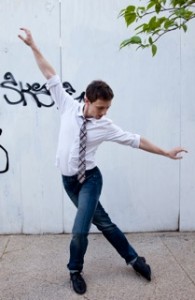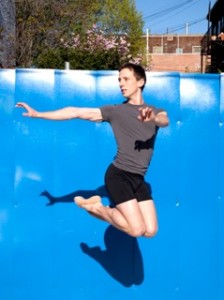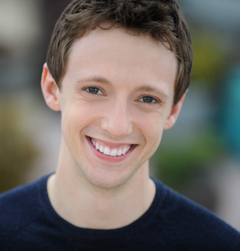Today for our “10 Questions With…” series we have Matthew Powell; choreographer, teacher and dancer…
1. How did you become involved with dance?
Like many male dancers, I entered the world of ballet because my sister was already taking lessons. She was put into ballet classes when she was little to correct a hip alignment issue she was born with. Every week, I would go with my parents to the studio to wait for her to finish. Since I was hanging around so much, the director invited me to come in and take class. Luckily, I had a wonderful teacher who loved to choreograph. Our days in the studio were filled with rehearsals of her ballets. I think if my time were spent doing only plies and tendus in class, I would easily have become bored. The intricacies of learning choreography, feeling the musicality, and finding ways to put a piece of myself into my dancing are what kept me coming back. I stayed at that little studio for ten years, until I left for the School of American Ballet. I am so grateful for my time there, because it taught me at an early age the importance of being an artist rather than just a dancer executing steps.

2. What are you currently doing in the field?
I am happy to say that I am very busy! This summer, I am teaching ballet classes at Broadway Dance Center, Peridance, Brooklyn Ballet, Petrov Ballet, and substitute teaching at Ballet Academy East. Later in the summer, I will be heading to Martha’s Vineyard to work as Ballet Master with Morphoses during their residency at the Vineyard Arts Project. While there, choreographers Jessica Lang and Pontus Lidberg will be creating new works to music by David Lang. These will be performed at the Works & Process series at the Guggenheim on October 3rd and 4th. Every aspect of this project excites and inspires me. To have the opportunity to be in the studio for five weeks with some of the world’s best dancers and choreographers is truly a gift. Morphoses is overflowing with artistic energy and positive vibes as the company grows into its new curatorial model, and I am so happy to be a part of it all.
3. You are a choreographer as well. What have you done, and how did you wind up going this direction?
Choreographing gives me the opportunity to create something physical out of the fantastic (and sometimes crazy) sensory episodes that whirl around in my mind when I hear a piece of music that I love. Some of my favorite nights have been spent plugged into an ipod, dancing around the apartment by myself with a glass of wine and a good piece of brie. It’s a very personal experience for me, and for this reason, it can sometimes be difficult to muster the self-confidence needed to move forward with a piece. I love being in the studio and the process of creating, but once my work hits the stage, it becomes business and a part of my livelihood! Still, I enjoy the artistic challenges choreographing provides, so I continue. My first work was performed at a choreographic workshop at the Kansas City Ballet. Over the next two years, my Artistic Director, William Whitener invited me to create new works for the company’s summer residency in Colorado. He then nominated me for a fellowship from the New York Choreographic Institute, which I received in 2006. That work, Resonant Dances, was then performed as part of Kansas City Ballet’s 50th Anniversary season.
4. Can you talk a bit about how you come up with the movements you select to go with the music? What is the process…
It’s hard to pin down any specific process that has worked best for me. I really go on a case-by-case scenario. Sometimes I create work on dancers I have known for years, so I have a good understanding of the way their bodies move best. Other times I am meeting the dancers for the first time the day we begin. When working with professionals, I like dancers to feel that the choreography I create for them meshes well with their strengths. This enables them to focus more on musicality and the overall feel of the piece. When I work with students, I often purposely create works that play on their weaknesses so they can use the piece as a means to become stronger dancers. Otherwise, my choreographic process is anyone’s guess!
5. What was the Crossroads Ballet Festival, and how were you involved with it?

The Crossroads Ballet Festival was an incredible labor of love, and one of the most satisfying experiences of my career. Though I was the Founder and Artistic Director, it was only made possible thanks to the collaboration of some really wonderful friends in the arts community. The festival combined the talents of dancers from nine different ballet companies for two evenings of classical ballet favorites, three newly commissioned works, and George Balanchine’s Stars and Stripes Pas de Deux. Dancers who participated in the festival came from New York City Ballet, Milwaukee Ballet, Cincinnati Ballet, Ballet Florida, Pacific Northwest Ballet, Staatsballett Berlin, Kansas City Ballet, Suzanne Farrell Ballet, and Sacramento Ballet. Because the festival was presented in the middle of the summer, I was able to provide dancers with good employment, and balletomanes with incredible performances at a time of year when ballet companies are typically on hiatus. We had budgeted for houses at 70% capacity, but ended up completely selling out, and had incredible audience response after each show. We took the small surplus we accrued and donated it to dance organizations in need. My hope is to someday take the festival on the road every summer and perform in cities that do not have (or no longer have) a professional ballet company. Classical ballet needs more exposure in order to survive, and by bringing professional dancers to these communities, I feel this festival could help show just how wonderful and important the art is. One can dream.
6. Would you share one of your career highlights?
I wore a vest for Allegro Brillante that had a shoestring-type front to it. I had done a lift with my partner and was sliding her down my chest. En route, her costume hook latched onto my vest…we were trapped. She next had to run across the stage in one of Balanchine’s signature winding patterns. Not realizing what had happened, she began to take me with her! Even worse was the fact that my vest was now drawn so tight it was restricting airflow. Frantic costume ripping ensued, and finally we were freed from each other. We still laugh about the fiasco to this day. Perhaps not a career highlight, but it was definitely a performance I will never forget.
7. What do you think are the most important qualities for a dancer to have?
Given the complexity and depth of artistry in today’s choreography, I think it’s important for dancers to be as versatile as possible. They should also be willing to drop inhibitions and take risks that may be out of their comfort zone. And, of course, they should have brilliant technique!
8. Is there any advice you can give specifically to men in ballet?
Thankfully, the social stigmas surrounding men in ballet have slowly become less of an issue over the years. However, it still can be tough, especially for younger male dancers. The best advice I can give is to work hard, be nice, and be patient – things will fall into place.
9. What is it that you love so much about dance?
I love dancing because it is an art that so perfectly combines the physical and emotional aspects of human nature. Even better is the fact that this marriage is mutually beneficial for both the audience member and the dancer. Throughout my career, I have tried to become as well rounded as possible so I could continue in this incredible field beyond my dancing years. Thankfully, I have been given some wonderful opportunities to do so. Yet, had these never presented themselves, I’d still find someway to stay with the art – I’d dance for nickels in the subway stations of New York if that’s what it took.
10. What is next for you?
I am excited about the prospects of working with such a pioneering company like Morphoses. I hope to continue to grow with them and contribute in any way I can. Along with that, I will be joining the summer faculty at the Rock School in Philadelphia, and traveling a bit for some other guest-teachings. I am in talks with a few places to choreograph new works as well. I’d also love to continue exploring the possibility of taking the Crossroads Ballet Festival on the road in the summers. This is the first time in my life I’ve worked solely as a freelance artist. It’s a little intimidating, but very exciting. I’m happy, healthy, and working in the field I love. What more could I ask for?

As a teacher, Matthew was a faculty member with the Kansas City Ballet School, and has taught classes at institutions such as the Universities of Iowa and Alabama, Marymount Manhattan, and Ballet Academy East. He has taught company class for Kansas City Ballet and Alvin Ailey American Dance Theatre while on tour. Additionally, Matthew served as the company ballet teacher for the West Side Story International Tour. He is currently teaching ballet at Broadway Dance Center and Peridance.
Matthew’s choreography received a fellowship from the New York Choreographic Institute in 2006. In 2008, he founded and directed the Crossroads Ballet Festival, a celebration of classical ballet performed by dancers from some of the world’s most renowned companies. He also worked as Assistant Director to Dorothy Danner for the Lyric Opera of Kansas City’s production of Pirates of Penzance. Most recently, Matthew has been working with Morphoses as Ballet Master, and will be guest teaching this summer at the Rock School in Philadelphia. http://matthewpowell.net






Bravo Matthew Powell! I have had the pleasure of knowing this talent for many years. Not only is he breathtaking to watch, but his soul is what shines through in his performance, choreography and every day demeanor. He is a delight in every way and I am proud to call him friend. May he continue to be blessed with a busy calendar and the abilitly to share his gift.